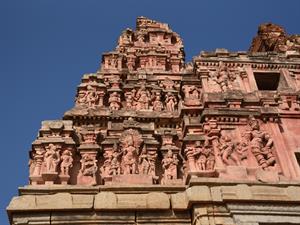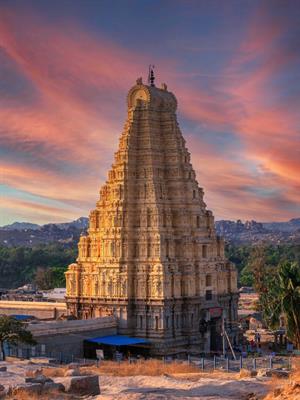
PUMPA - SMART LEARNING
எங்கள் ஆசிரியர்களுடன் 1-ஆன்-1 ஆலோசனை நேரத்தைப் பெறுங்கள். டாப்பர் ஆவதற்கு நாங்கள் பயிற்சி அளிப்போம்
Book Free DemoTemple construction under Vijayanagar empire:
The Vijayanagara architecture displayed huge grandeur and various new features that were not seen before among the contemporaries. The Vijayanagara architecture introduced a new tradition of using “hard stones” compared to the earlier soft stones.
Provida Style: The Vijayanagara architecture mostly adopted the principles of the Dravidian style, but at the same time, it also had its unique features, which gave birth to a new style named the “Provida style''.
Features of the Vijayanagara temples:
The temples constructed under the Vijayanagar reign had the following characteristics.
1. Horizontal elaboration of Temples.
2. Ornamentation of pillars and walls increased.
3. Construction of high compound walls.
4. Sanctums are built with intricate carvings.
5. The establishment of Amman Shrines, where the spouse of the main deity was kept.
The sculptures and niches were given high importance during the Vijayanagar reign, which was evident in the temples constructed during their period.
Mandapams:
The most important feature of the Vijayanagara architecture was the “Mandapams” or the Open Pavilions, which were raised on a platform. These structures are established for the seating of the main deity during a festival.

Vittal temple
The Mandapams also contain Pillared halls which the devotees use to take a view during the festival.
A Lion sitting on top of the pillars in Mandapams is a common feature of the Hindu temples in Tamil Nadu.
The Kalyana Mandapams are a unique set of Mandapams established to perform rituals like a marriage of the deities during special occasions.
Some of the notable temples with Mandapa architecture are:
1. Varadaraja Perumal temple – Kanchipuram
2. Jalagandeshwara temple – Vellore
3. Vittal temple Mandapa - Hampi
4. Pudhu Mandapam – Madurai
5. Vanamamalai temple – Nanguneri
2. Pillars:
The period of the \(16^{th}\) century witnessed the pinnacle of Vijayanagar architecture. This period brought a new element named the “Composite Pillars” which blended features from South and the Deccan architecture.
Large pillars with delicate carvings of the deities and the mystical elements are a unique feature of the pillar architecture of the Vijayanagar empire.
The Pillars accompanied by elaborate halls in the central part with numerous animal figures are mostly found in Vijayanagar temples.
Horse: The picture of the horse was the most commonly sculpted image in the pillars of Vijayanagar temples and Mandapas.
Most of the other pillars in Vijayanagar temples contain sculptures from epics like Mahabharata and Ramayana.
Ranganatha Temple (Srirangam), Nellaiappar Temple (Tirunelveli), Alakiya Nambi Temple (Tirukkurungudi) are some of the finest examples of pillared halls in Tamil Nadu.
Gopurams:
The Gopurams constructed by the Vijayanagar Kings stand the test of time and it displays the penchant of the rulers.

Rajagopuram
These are pyramidal structures with multiple stories which stand tall and majestic is known as the “Rajagopuram”.
Krishna Devaraya: He was the ruler of the Tuluva dynasty of the Vijayanagar empire under whose reign the Gopuram construction reached its zenith.
1. The Period of modern architecture began in the \(17^t\)\(^h\) century under the Sethupathi’s who belonged to the Ramanathapuram and Sivagangai regions.
2. The Nayak kings appointed his feudatories to take care of the pilgrims who travelled from Sethusamudram to Rameshwaram. The protectors of the Sethusamudram regions came to be known as “Sethupathi’s”.
Raghunatha Sethupathi: The second Prakaram of the Ramanathasamy temple was constructed by him. He also patronised “Thayumanavar'' a famous poet who spent his last days under Raghunatha Sethupathi.
3. The Sethupathi’s contributed to the construction of the Ramanathaswamy temple in Rameshwaram, which has the world’s longest corridor.